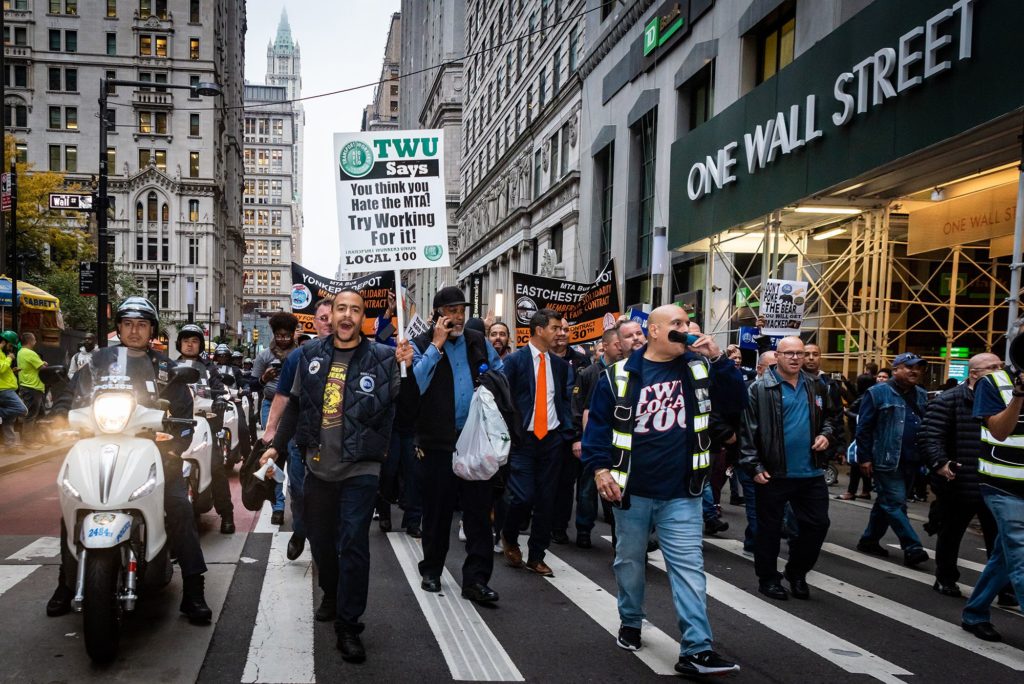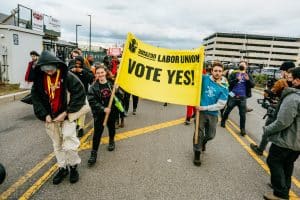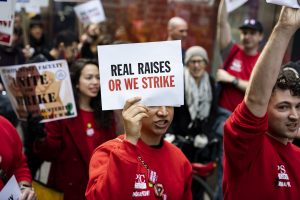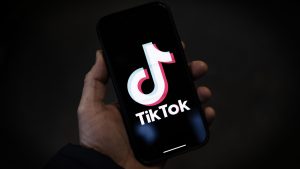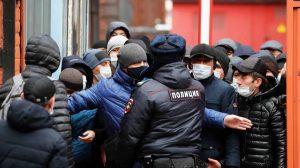Fifteen years ago this week, 34,000 members of Transportation Workers Union Local 100 went on strike, shutting down train and bus service and bringing New York City to a screeching halt. Eric Josephson, interviewed here, is a retired transit worker and member of the League for the Revolutionary Party who participated in the strike and was active in the union for 30 years.
How did you come to work in transit?
I worked a number of dangerous, dirty factory jobs in Chicago, New York, and New Jersey, and took many civil service tests, including for New York City Transit, looking for any job for which I had the qualifications or could fake them. I finally got the Trackworker job. I did that for almost 20 years, and I was a Trackwalker (track inspector) for almost 10.
What did you do every day? What were the track jobs like?
As a Trackworker, I worked in workgangs of up to 40, depending on the job, and with other job titles, flame-cutting out worn-out rails or whole panels (sections of track) and replacing them. Such work requires rail or track cranes mounted on diesel cars and is almost always done with traffic diverted or stopped. Smaller jobs — replacement of one rail or some joint bars (which fasten rails together), walkway replacement — “Track Maintenance” — require smaller groups and are often done “Under Traffic.” This requires safety flags or lanterns, and one or more safety flaggers. As a Trackwalker, I went out on the tracks with at least one safety flagger and made minor repairs and reported defects.
My experience is that Track Supervisors and Superintendents tend to cut corners on safety. As Shop Steward and as two-term vice-chair of the Track Division, I sometimes had to order jobs stopped until the bosses corrected bad flagging or other unsafe conditions.
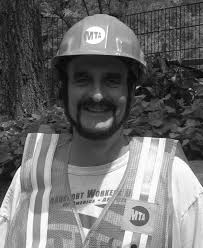
Could you briefly explain when and how you became a Trotskyist?
My family political background is German social-democratic. I was anti-Stalinist on democratic grounds, and joined the Young People’s Socialist League (social-democratic youth) in Pittsburgh, Pennsylvania, in the 1960s. I grew to oppose the U.S. imperialist war and became dissatisfied with YPSL declining to take a position on Vietnam.
I became a member of Students for a Democratic Society, and was a delegate to the 1969 SDS Convention. I saw various Maoists wreck attempts at unity, erasing any lingering illusions I might have had about Stalinism. I joined the International Socialists, the left-Shactmanite regroupment (not the ISO) in Chicago in 1969, where I briefly went to school. The left of IS, organized as the Revolutionary Tendency (RT), moved in 1973 to oppose Shactmanism and become Trotskyists. I joined them, and the left-Shactmanite majority expelled us in 1972. In that faction fight, I became a full-fledged Trotskyist.
How did you conceptualize doing political work in the union, and what was the role of the Revolutionary Transit Worker publication?
The LRP put out leaflets and other literature in its own name starting in 1986. Revolutionary Transit Worker (RTW) started in January 2001. We put out openly communist literature shortly after the one-year probation ended, and we determined that it wouldn’t immediately endanger my job. We regarded RTW as the transit-worker arm of the LRP, as a bulletin and communist fraction in TWU Local 100. The task of RTW was to build the revolutionary party in transit by winning the most advanced transit workers through communist leaflets and bulletins, and through joint struggle against the capitalists.
RTW looked for demands that spoke to transit workers, to be sure, but which would tend to unite the whole working class against the capitalist class. RTW emphasized the general strike and the repudiation of the debt to banks, corporations, and the rich. RTW explained that we must fight for our demands, but to win lasting gains would require socialist revolution.
I often worked with the main opposition in Local 100, New Directions, a reform caucus sheltering many hidden socialists. But I had to oppose their opportunism and growing orientation to the Democratic Party and to wings of the “old-guard” union bureaucracy. Roger Toussaint, a long-ago supporter of the Marxist-Leninist Party and late-comer to New Directions, liquidated ND in 2001, five months after he became Local 100 president.
TWU 100 struck in 1966, and again in 1980. How did those strikes set the tone for union activism when you became a transit worker?
The 11-day strike in 1966 was a smashing success, a high point of the U.S. strike wave of the mid-1960s to the early 1970s. The auto strikes in Detroit and Ohio, the League of Revolutionary Black Workers, and the national postal strike of 1970 were some other high points. The Black liberation movement was key in causing this unprecedented — and largely unsung — strike wave. Illegal public-sector strikes featured plurality-Black participation and raised up a new, Black leadership. The transit workers’ open flouting of the anti-strike Condon-Wadlin Law of the time smashed that law, and the strikers suffered no penalties — except that Michael Quill, the Local 100 president, was sentenced to jail. The union bureaucrats and Democratic Party politicians worked quickly to bury and obscure the powerful strike wave.
In 1981, President Ronald Reagan fired the entire body of striking air traffic controllers who were members of the PATCO union. In New York, transit worker dissatisfaction led to the strike of 1980. Mayor Ed Koch, a conservative Democrat, led a veritable crusade against the strike, and Local 100 President John Lawe sabotaged it. The workers went back to work after 11 days with nothing [a claim that has been disputed]. I heard only of demoralization and disgust about the 1980 strike from participants. But they had thrown a scare into the capitalists: arbitration two years later awarded the transit workers wage hikes above inflation, plus benefit improvements.
What led to the 2005 strike?
The MTA, New York City’s transit authority, asked for the strike. They were well aware of the workers’ growing anger and militancy. Minimal or no pay hikes, demands for healthcare givebacks, and a vicious disciplinary process had aggravated us beyond endurance. At one point, there were more disciplines than members in Rapid Transit Operations!
Twice before, in 1999 and 2002, we had voted overwhelmingly at general membership meetings to strike or “authorize” the Local leadership to call a strike. In 1999, President Willie James slapped the members’ vote aside, and in 2002 the new “militant” President Roger Toussaint did the same, both agreeing to successive contracts with “double zeros” — two years with no raise. Toussaint had also bargained away our no-layoffs clause and left hundreds of “reclassified” skilled trades workers to the mercy of the arbitrator.
In 2005, there was no stopping the drive to strike.The contract expired on December 15. Toussaint repeatedly proclaimed, “A deadline is a deadline” — and then let it pass. But the anger of the ranks, plus the MTA’s intransigence, forced him finally to go out five days later.
What was the impact of the strike?
From December 20 through December 22, 2005, 35,000 bus and subway workers — mostly members of Transport Workers Union Local 100 — shut down the biggest city in North America. Thousands of us had voted for this at a raucous meeting at the Javits Center on December 10. Together with bus workers in Amalgamated Transit Union Locals 726 (Staten Island) and 1056 (Queens Corona Yard), we hit at the heart of world capitalism. Other New York workers, from teachers to factory workers to construction laborers, visited our picket lines to bring us food and drink and show support.
The strike was a great opportunity for the antiracist, anticapitalist fight. New York City transit workers are majority people of color, many of them immigrants or the children of immigrants. Toussaint came from Trinidad. A transit strike in the city is virtually a general strike of Black and Brown workers. And it immediately raises the question of the general strike, even for many workers with low class-consciousness. Before and during the strike, workers on the Long Island Rail Road and Metro-North commuter rail lines had offered to shut down parts or all of their lines, if New York City transit workers agreed to set up strategically located picket lines for them to honor. But Toussaint dismissed this out of hand.
How did the strike end? Who won?
Christmas was a few days away, and merchants were clamoring for a settlement. You’d think that any transit worker union member or leader would figure that everything was going our way, for once, and we should hold out. For transit workers new to mass struggle — most of them — a new way of acting and thinking was just starting to take shape. The strike was inspiring, and brought out the best in the strikers. The whole world was watching!
But in three days, Toussaint ordered us all back to work with no contract whatever, and damn little information. I and other picketers heard about the back-to-work order from capitalist radio stations, not our own union. In fact, the Union Hall issued almost no news or information from before the strike until several days after.
We were right to strike. I’d do it again. But the working class will never learn how to fight the capitalists if we don’t learn from defeats and mistakes. Thousands of honest working-class fighters sacrificed to strike for themselves and, many understood, for the whole working class. They suffered a betrayal by Toussaint. Seeing no powerful alternative leadership, many sank into demoralization and in effect, turned against unions.
Following the strike, the membership initially voted down the new contract?
Toussaint and the majority of the executive board that supported him commenced a whirlwind sales drive for the contract in every borough. For Toussaint, the tour was a disaster, as many members had started a contract rejection movement — as had RTW. At Toussaint’s largest event, in the Brooklyn YMCA, the members’ shouts and denunciations drowned out the sales pitch. Some of his officers actually came to blows with rank-and-file contract opponents. At the Bronx Borough Community College event, Toussaint faced highly skeptical Train Operators and Conductors, mostly, who asked increasingly sharp questions. Halfway through the allotted time, most of the audience marched out chanting, “Vote No! Vote No!” — in effect, turning the event into a contract rejection rally.
The LRP joined with various other elements in building the Vote No Coalition (VNC). We held several meetings and leafletted in the field. It was not a hard case to make. The major new giveback, the 1.5-percent healthcare deduction, was set to increase with healthcare costs, and the wage hike left us behind inflation, given the two previous contracts with double zeros. A vote was held on January 20, 2006, and we defeated the contract — by 7 votes!
Toussaint did not accept the members’ vote. Although the MTA had by then legally retracted the rejected contract offer, Toussaint insisted on voting on it again, campaigning full out, in a way he never had for the strike or any militant mass action. In April, the exhausted, demoralized membership passed the contract by over 70 percent. About the same time, Justice Theodore T. Jones, a Black Democratic Party judge, took away the union’s right to dues checkoff, and sentenced Toussaint to 10 days in jail. He served four, with nights at home.
What lessons can workers learn from the 2005 strike?
Workers and capitalists around the world looked to our fight with hope — or foreboding. The capitalist media and government officials went apoplectic at this display of working-class power. The national TWU president, Frank O’Brien, and other top leaders actually sent out a mass call for us to scab and break the strike! We cursed them and ignored their scabbing call. A column in the reactionary New York Daily News called our strike “the last great battle of the 20th century,” hoping to see transit workers and all organized, fighting workers crushed. But for us, the strike was the first great battle of the 21st century.
But we should learn what not to do as well. No matter how hard we push pro-capitalist union leaders, they will ultimately, unmistakably turn against the workers’ struggle. So the workers’ fight to defend ourselves against capitalist attacks must be a fight against the capitalists’ agents in the unions, the bureaucratic misleaders.
*This interview was conducted over email from December 18-27, 2020. Some factual errors were corrected after the initial publication.


